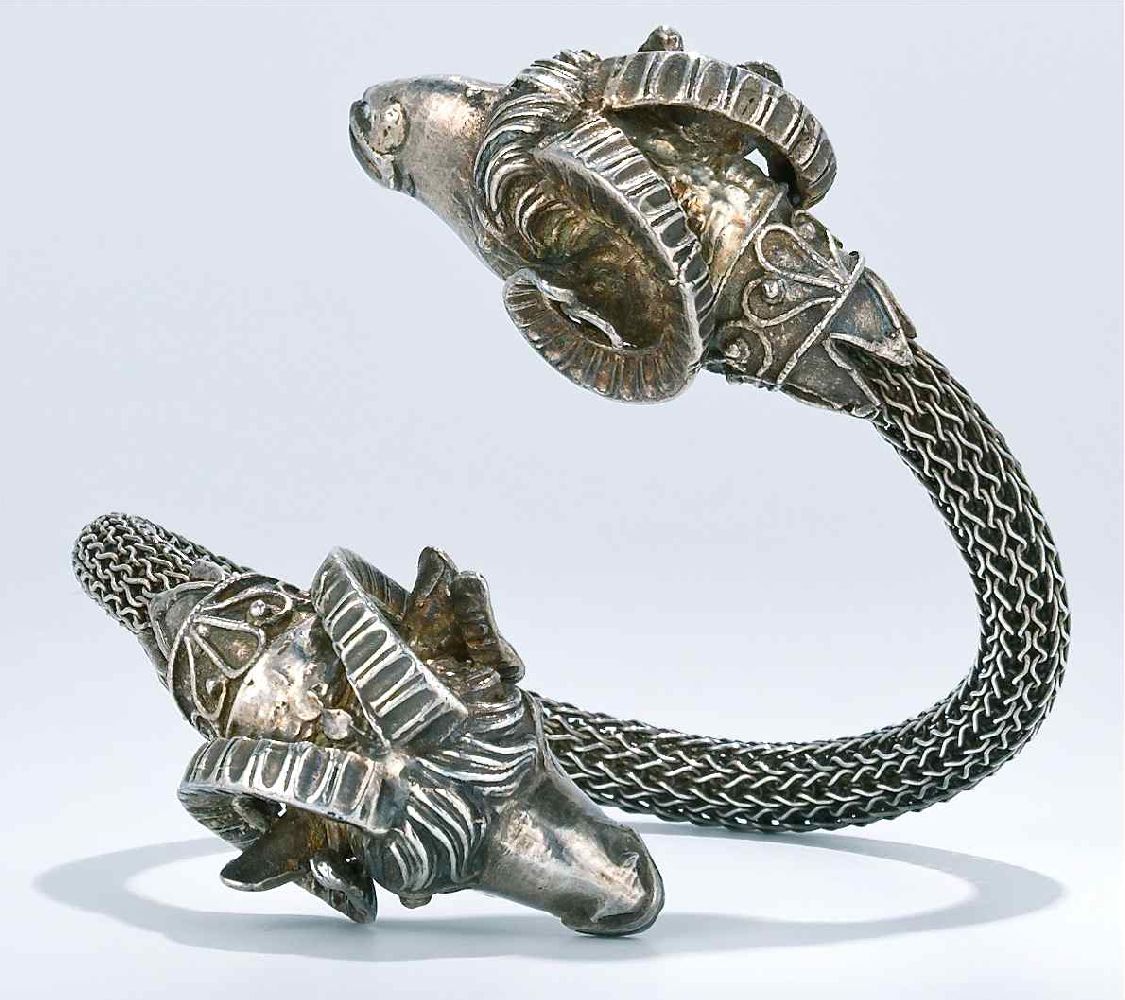

Title: Ancient Greek Silver Archaic Ram Design Bracelet Torc Jewelry
Shipping: $29.00
Artist: N/A
Period: 20th Century
History: N/A
Origin: N/A
Condition: Excellent
Item Date: 1940 to 1960
Item ID: 5619
A Greek Silver Ram Design Bracelet. 2"W Silver torque bypass bracelet designed with ram head terminals; overall weight 46.2 gm. A nice looking ancient bangle with a greek design, either from ancient Greece or from Achemenid civilisation, with a double headed silver ancient Ram torc bangle. Condition: Overall good. Memorizing archaic Ram's head torc bracelet. A museum quality reproduction in Silver. Such intricate and quality-made pieces demonstrate the characteristic unique value of Greek artisan silversmithery with all its diachronic finesse. Torc jewelry describes ancient jewelry that was open ended in the front (as necklaces or bracelets) and usually contained decorative ornate animal heads on either side of the opening. This motif renders the attributes of design and decoration of gold and silver artifacts from the archaic period. There are great similarities found between Celtic and Greek torcs of this type, as this rhythm was known to have existed all over Europe. The oldest type of torc (or torque latin) jewelry known were excavated in classical Greek burial tombs. Famous celric torcs, much later were also found in tombs of Celtic princes. Many historians argue that they were a sign of nobility while others suggest the torc to have been a decoration awarded to warriors for their deeds in battle. Before this predominantly masculine form of decoration, torc jewelry is know to have also been a feminine form of jewelry (before 4 B.C) Beautifully crafted with vivid detail, completely hand-made. We are committed to enhancing our customer’s lives by discovering creating, and pointing out only the best art we can find in the world today. We Are Taste-Makers, Art Advisers & Consultants.
Link: http://en.wikipedia.org/wiki/Torc
A torc, also spelled torq or torque, is a large, usually rigid, neck ring typically made from strands of metal twisted together. The great majority are open-ended at the front, although many seem designed for near-permanent wear and would have been difficult to remove. Smaller torcs worn around the wrist are called bracelets instead. Torcs are found in the Scythian, Illyrian[1] Thracian, Celtic, and other cultures of the European Iron Age from around the 8th century BC to the 3rd century AD. The Celtic torc disappears in the Migration Period, but during the Viking Age torc-style metal necklaces came back into fashion.
The word comes from Latin torquis (or torques), from torqueo, "to twist", because of the twisted shape of the collar. The ends of ancient torcs typically bore sculpted ornaments, frequently globes, cubes, or animal heads, and, less commonly, human figures. The body of the necklace was usually but not always wrapped. Although they were most often neck rings, there were also bracelets with this shape. Basic torcs were made from intertwined metal rods, or "ropes" of twisted wire, usually gold or bronze, less often silver, iron or other metals, but elaborate examples, sometimes hollow, used a variety of techniques.
The torc first appears in Scythian art from the Early Iron Age, introduced to Celtic Europe around 500 BC. An early Scythian torc is part of the Pereshchepina hoard of the 7th century BC. Later examples are found in the Tolstaya burial and the Karagodeuashk kurgan (Kuban area), both dating to the 4th century BC.
It also has predecessors in gold necklaces of the European Bronze Age, which are sometimes also called "torcs", for example, the three 12th–11th-century BC specimens found at Tiers Cross, Pembrokeshire, Wales, and the Milton Keynes Hoard, which contained two large examples.
One of the earliest known depictions of a torc can be found on the Warrior of Hirschlanden (6th century BC). The famous Hellenistic/Roman sculpture The Dying Gaul also wears one.
Depictions of the gods and goddesses of Celtic mythology frequently show them wearing torcs. The famous Roman copy of the original Greek sculpture The Dying Gaul depicts a wounded Gaulish warrior naked except for a torc. Examples have been discovered in Europe during archaeological surveys.